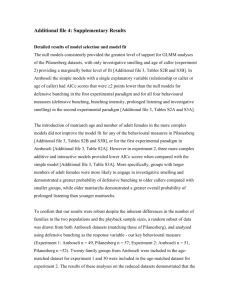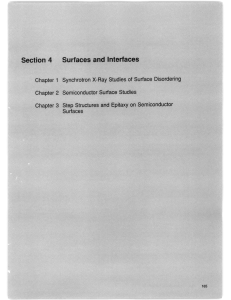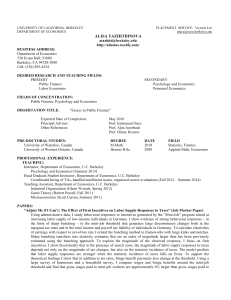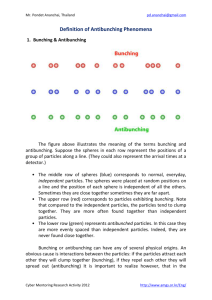Frictions and the elasticity of taxable income:
advertisement
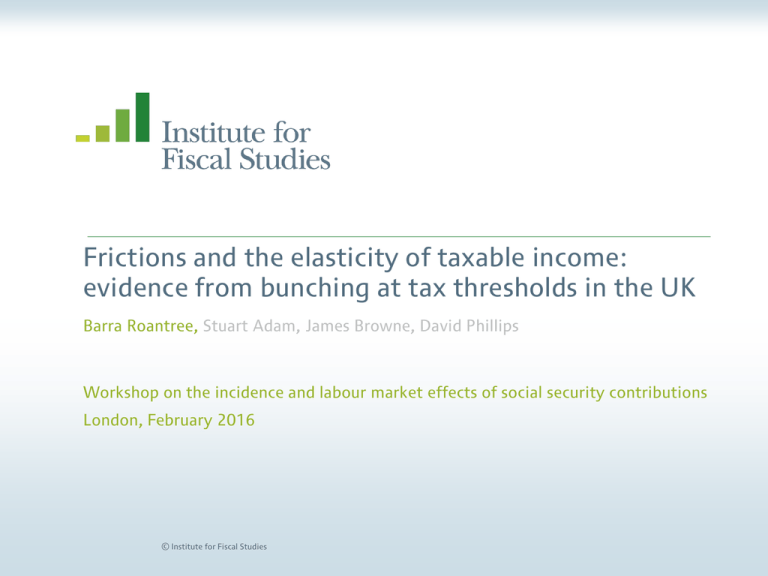
Frictions and the elasticity of taxable income: evidence from bunching at tax thresholds in the UK Barra Roantree, Stuart Adam, James Browne, David Phillips Workshop on the incidence and labour market effects of social security contributions London, February 2016 © Institute for Fiscal Studies Introduction • Large literature seeks to estimate responsiveness of agents to taxes – Key determinant of revenues from and efficiency costs of taxation – Under certain conditions, elasticity of taxable income (ETI) is a sufficient statistic that measures the excess burden of taxes (Feldstein, 1999) – But optimising frictions can attenuate reduced-form estimates of the elasticity of taxable income or labour supply (Chetty, 2012) • Paper exploits cross-sectional variation created by tax thresholds in the UK to estimate the ETI and magnitude of frictions workers face – Rise in marginal or average tax rate at threshold should create bunching that can use to estimate ETI (Saez, 2010; Kleven & Waseem, 2013) – Look at lots of thresholds, in many years, at different earnings levels and across groups to see where and when bunching happens (& by who) © Institute for Fiscal Studies Outline 1. Thresholds in the UK personal tax system 2. The economics and econometrics of bunching a) Bunching at kink-points (increase in marginal rate) b) Bunching at notches (increase in average rate) 3. Data 4. Results a) Bunching at kink-points b) Bunching at notches 5. Conclusions © Institute for Fiscal Studies Outline 1. Thresholds in the UK personal tax system 2. The economics and econometrics of bunching a) Bunching at kink-points (increase in marginal rate) b) Bunching at notches (increase in average rate) 3. Data 4. Results a) Bunching at kink-points b) Bunching at notches 5. Conclusions © Institute for Fiscal Studies Thresholds in the UK personal tax system • Several kinks in income tax schedule – Higher-rate threshold (HRT): rate rises from 20-40% ~£40k – Additional-rate threshold: rate rises from 40-50% at £150k – Personal allowance above which income tax starts to be paid – Personal allowance withdrawn from £100k: rate rises from 40-60% at £100k and falls back from 60-40% ~£113k • Earnings also subject to National Insurance contributions (NICs) – Nominally paid by both employees and employers – Very weak link to benefit entitlement unlike in rest of EU or US – Lower Earnings Limit (LEL): big notch 1978-85, reduced 1985 and 1989 – Three notches above the LEL from 1986-1998 – NICs capped at Upper Earnings Limit before 1985 (fall in marginal rate) – Kinks at Primary & Secondary Thresholds from 1998 onwards © Institute for Fiscal Studies Outline 1. Thresholds in the UK personal tax system 2. The economics and econometrics of bunching a) Bunching at kink-points (increase in marginal rate) b) Bunching at notches (increase in average rate) 3. Data 4. Results a) Bunching at kink-points b) Bunching at notches 5. Conclusions © Institute for Fiscal Studies Bunching at kink points With smooth tax schedule With kinked tax schedule Density distribution B k k + Δz Before-tax income z Bunching at kink points • With smooth distribution of (convex) preferences, people should bunch sharply at thresholds where marginal rate increases – Amount of bunching proportional to compensated ETI locally – Saez (2010) derived method to estimate the excess (bunching) mass at a kink-point and from this the compensated ETI – Should also see dip in distribution where marginal rate falls • But optimisation frictions mean some individuals won’t/can’t bunch – e.g. adjustment costs, hours constraints, inattention, – Attenuates estimates of elasticity from bunching at kink-points – Fundamental problem that can’t distinguish low ETI from high frictions © Institute for Fiscal Studies Outline 1. Thresholds in the UK personal tax system 2. The economics and econometrics of bunching a) Bunching at kink-points (increase in marginal rate) b) Bunching at notches (increase in average rate) 3. Data 4. Results a) Bunching at kink-points b) Bunching at notches 5. Conclusions © Institute for Fiscal Studies Bunching at notches Notches create dominated region no one should locate in… 2500 Obs in £100 bins 2000 No-notch density Density with notch 1. Bunching below threshold 3. Gradual convergence back to no-notch density 1500 1000 2. Zero mass in dominated region 500 0 N N+D Distance from threshold © Institute for Fiscal Studies Bunching at notches … unless they face substantial frictions 2500 Obs in £100 bins 2000 No-notch density Density with notch Bunching mass diffuse, not sharp 2. Gives estimate of ratio of observed to counterfactual density in dominated region: Call this a*=a(ϕ) 1500 1000 1. Estimate no-notch counterfactual 500 See some mass in dominated region 0 N N+D Distance from threshold © Institute for Fiscal Studies Bunching at notches Use estimate of frictions a* to get unattenuated response Δz 2500 No-notch density Density with notch 3. Scale bunching up by a* Obs in £100 bins 2000 2. Gives estimate of ratio of observed to counterfactual density in dominated region: Call this a*=a(ϕ) 1500 1000 500 1. Estimate no-notch counterfactual Assumes a(ϕ) locally constant: biases earnings response down 4. … and back out earnings response of marginal buncher 0 N N+D Distance from threshold © Institute for Fiscal Studies Bunching at notches … and so the unattenuated elasticity ε • Kleven and Waseem (2013) propose two ways to get unattenuated elasticity ε from this earnings response Δz 1. ‘Structural approach’ – Specifying a functional form for utility yields expression that links % earnings response, % change in net-of-tax rate, and elasticity – Use quasi-linear utility specification: ignores income effects and get mixture of compensated and uncompensated elasticity 2. ‘Reduced-form approach’ – Use implicit marginal tax rate created by notch between N and N+Δz – … but the notch generates larger earnings response than hypothetical kink, so will overstate the compensated elasticity © Institute for Fiscal Studies Outline 1. Thresholds in the UK personal tax system 2. The economics and econometrics of bunching a) Bunching at kink-points (increase in marginal rate) b) Bunching at notches (increase in average rate) 3. Data 4. Results a) Bunching at kink-points b) Bunching at notches 5. Conclusions © Institute for Fiscal Studies Use large admin and employer survey datasets • Survey of Personal Incomes (SPI): 2003-2011 – Sample of income tax administrative records (~700,000 observations) – But doesn’t include non-taxpayers (e.g. those below Personal Allowance) • New Earnings Survey (NES): 1978– Large mandatory employer survey – Targets 1% random sample of civilian employees using NI numbers – Little measurement error & gives earnings in correct period for NICs – But some problems: 1. Incomplete sample below LEL: we might understate bunching 2. Earnings reported for period around turn of fiscal year: dual thresholds mean will pick up mixture of immediate and medium-run responses © Institute for Fiscal Studies Outline 1. Thresholds in the UK personal tax system 2. The economics and econometrics of bunching a. Bunching at kink-points (increase in marginal rate) b. Bunching at notches (increase in average rate) 3. Data 4. Results a. Bunching at kink-points b. Bunching at notches 5. Conclusions © Institute for Fiscal Studies Do see bunching at the higher-rate threshold SPI data from 2003-04 to 2007-08 Observations per £100 bin 2500 2000 1500 1000 500 0 Distance from higher rate threshold, £ p.a. © Institute for Fiscal Studies Note: All figures in 2007–08 prices. Source: 2003–04 to 2007–08 SPI. … but driven by company owner-managers SPI data from 2003-04 to 2007-08 Observations per £100 bin 2500 Employees/other Self-employed Company owner-managers 2000 1500 1000 500 0 Distance from higher rate threshold, £ p.a. © Institute for Fiscal Studies Note: All figures in 2007–08 prices. Source: 2003–04 to 2007–08 SPI. … and implies very small elasticities Table 2 Kink Higher rate threshold All taxpayers Self-employed Company owner managers Other taxpayers 0.032*** 0.058*** 0.246*** 0.015*** £100,000 £150,000 Note: ** = statistically significant at 5%, *** = statistically significant at 1% level. Source: Author’s calculations using 2003–04 to 2007–08 Survey of Personal Incomes. © Institute for Fiscal Studies … as does bunching at the 100k threshold Table 2 Kink All taxpayers Self-employed Company owner managers Other taxpayers Higher rate threshold 0.032*** 0.058*** 0.246*** 0.015*** £100,000 0.014*** 0.020*** 0.039*** 0.007** £150,000 Note: ** = statistically significant at 5%, *** = statistically significant at 1% level. Source: Author’s calculations using 2003–04 to 2007–08 Survey of Personal Incomes. © Institute for Fiscal Studies … and the 150k threshold Table 2 Kink All taxpayers Self-employed Company owner managers Other taxpayers Higher rate threshold 0.032*** 0.058*** 0.246*** 0.015*** £100,000 0.014*** 0.020*** 0.039*** 0.007** £150,000 0.022*** 0.011 0.070*** 0.015*** Note: ** = statistically significant at 5%, *** = statistically significant at 1% level. Source: Author’s calculations using 2003–04 to 2007–08 Survey of Personal Incomes. © Institute for Fiscal Studies But frictions could explain results at kinks • Little bunching at income tax kinks, implying small elasticities – … even for the self-employed & company owner-managers • No bunching at kinks in NICs schedule from 1998 where rate rises – … nor any dip at thresholds where income tax/NICs rate falls • Could be that underlying responsiveness small – … but estimates seem implausibly small • Estimates are consistent with larger elasticities if allow for frictions: with adjustment cost of 1% net earnings: – @100k: all taxpayers estimate of 0.01 could be = 0.49 – @HRT: company owner-manager estimate of 0.25 could be = 1.58 – @150k: self-employed estimate of 0.01 could be = 2.35 © Institute for Fiscal Studies Outline 1. Thresholds in the UK personal tax system 2. The economics and econometrics of bunching a. Bunching at kink-points (increase in marginal rate) b. Bunching at notches (increase in average rate) 3. Data 4. Results a. Bunching at kink-points b. Bunching at notches 5. Conclusions © Institute for Fiscal Studies See some bunching at LEL notch from 1978–85 … which implies unattenuated elasticity of ~ 0.10 1978-85 1986-89 1990-99 Reduced-form approach Bunching-hole method s.e. 0.0965 (0.0014) Structural approach Bunching-hole method s.e. 0.0430 (0.0009) Actual/counterfactual density in bunching region Actual/counterfactual density in dominated region Δz/z convergence method Δz/z bunching-hole method Polynomial order 1.0904 0.8737 14.5% 23% 12 Note: Bootstraped standard errors in italics calculated drawing with-replacement from the observed distribution. Source: Author’s calculations using New Earnings Survey, 1978-1999 © Institute for Fiscal Studies Sharper bunching between 1986 and 1989 … but frictions fall, limiting rise in elasticity 1978-85 1986-89 1990-99 Reduced-form approach Bunching-hole method s.e. 0.0965 0.3210 (0.0014) (0.0046) Structural approach Bunching-hole method s.e. 0.0430 0.2221 (0.0009) (0.0036) Actual/counterfactual density in bunching region Actual/counterfactual density in dominated region Δz/z convergence method Δz/z bunching-hole method Polynomial order 1.0904 0.8737 14.5% 23% 12 1.1468 0.8257 16% 28.25% 12 Note: Bootstraped standard errors in italics calculated drawing with-replacement from the observed distribution. Source: Author’s calculations using New Earnings Survey, 1978-1999 © Institute for Fiscal Studies Bunching sharper again between 1990–99 … and frictions larger, giving estimate of 0.5–0.7 1978-85 1986-89 1990-99 Reduced-form approach Bunching-hole method s.e. 0.0965 0.3210 0.6891 (0.0014) (0.0046) (0.0210) Structural approach Bunching-hole method s.e. 0.0430 0.2221 0.5403 (0.0009) (0.0036) (0.0186) Actual/counterfactual density in bunching region Actual/counterfactual density in dominated region Δz/z convergence method Δz/z bunching-hole method Polynomial order 1.0904 0.8737 14.5% 23% 12 1.1468 0.8257 16% 28.25% 12 Note: Bootstraped standard errors in italics calculated drawing with-replacement from the observed distribution. Source: Author’s calculations using New Earnings Survey, 1978-1999 © Institute for Fiscal Studies 1.1493 0.8932 38.5% 52.25% 15 But some caveats on these elasticity estimates… • Data problems – Might understate bunching below threshold – Can overstate frictions when notch is small and dominated regions from tax years ending 5 April/starting 6 April don’t overlap – Ambiguous effect on estimate of unattenuated elasticity • Even with ~1% sample data quite noisy – Makes identifying bunching region and estimating counterfactual hard • Local estimate for particular group from quite some time ago – Low-earning employees in the 1980s & 1990s © Institute for Fiscal Studies Yet evidence frictions v. large for most workers • Observe large mass in dominated region above LEL 1978-85: – => frictions large enough to prevent majority of employees relocating just below threshold where taxes up to 17% of earnings lower • Complete absence of bunching at notches higher up distribution: – locating in dominated region at third notch in 1989 => additional tax wedge of ~£500 on earnings of ~£18k per year (April 2012 prices) – Notches at dense part of earnings distribution effecting many workers: e.g. in 1989 at 0.8, 1 and 2 times median earnings • Also find interesting heterogeneity in frictions faced across groups: – At LEL see no missing mass for FT employees => very high frictions – But plenty for PT employees => lower frictions (mostly women) – Employees in retail/hospitality sector also face lower frictions © Institute for Fiscal Studies Outline 1. Thresholds in the UK personal tax system 2. The economics and econometrics of bunching a. Bunching at kink-points (increase in marginal rate) b. Bunching at notches (increase in average rate) 3. Data 4. Results a. Bunching at kink-points b. Bunching at notches 5. Conclusions © Institute for Fiscal Studies Conclusions (1/3) • Some bunching at income tax kinks, but implied elasticities small – … even for company owner-managers at HRT who drive bunching – … and likely attenuated by frictions such as adjustment costs • No evidence of bunching at smaller NICs kinks • Some bunching at notch where NICs became payable (LEL) – implies local unattenuated elasticity of 0.1-0.7 – … though some problems with data here • No bunching at the NICs notches above LEL – implies large frictions for employees at 0.8 to 2 times median earnings – Sufficient to help reconcile macro and micro elasticity estimates? © Institute for Fiscal Studies Conclusions (2/3) • Little bunching at 100k or 150k income tax thresholds and more bunching at LEL from 1985 despite smaller notch: salience? – 100k/150k thresholds new & 60% band not transparently described – Nigel Lawson made much of reforming the notch: increased salience? • Find heterogeneity in frictions that corresponds to well-documented differences in elasticity estimates – Men/FT workers face far higher frictions than women/PT workers – Might also explain why company owner-managers bunch more at kinks – Is literature estimating differences in preferences or frictions? • But also find variation in frictions across sectors e.g. lower in retail – Hours constraints imposed by firms? – Reminder that ETI can capture labour demand responses too © Institute for Fiscal Studies Conclusions (3/3) • And are we implicitly assuming something about incidence? – Taxable income/hours elasticities usually interpreted as labour supply/individual preference parameters: lit. rarely mentions demand – If labour demand perfectly elastic => incidence fully on employees – What if labour demand not perfectly elastic? Is there then an identification or just an interpretation issue? © Institute for Fiscal Studies

